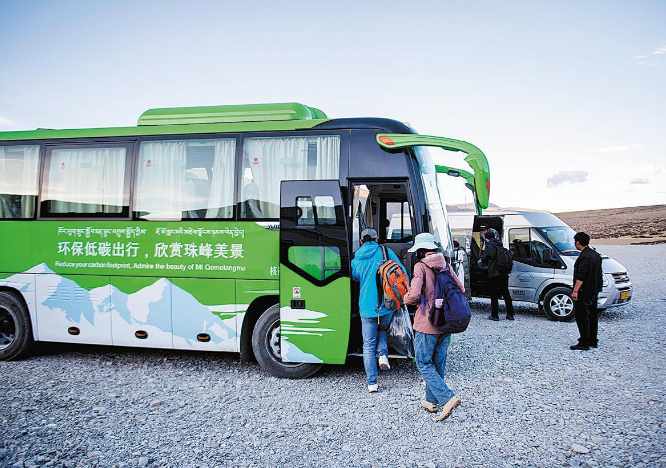Electric vehicle sales increase in Tibet as infrastructure expanded
Updated: 2023-10-18 By Palden Nyima and Daqiong in Lhasa (China Daily)  Print
Print 



Visitors get onto a new energy shuttle bus in the parking lot of a scenic area in the Tibet autonomous region. SUN FEI/XINHUA
Growing charging infrastructure is making it easier to travel in the Tibet autonomous region by electric vehicle.
The latest edition is a supercharging station built in Metog county, a famous tourist destination more than 700 kilometers from the regional capital Lhasa. The station is supported by CATL, a global leader in electric power batteries, according to ThePaper.cn on Monday.
The station is a significant step toward developing the new energy vehicle market in Tibet, which lags behind China's more developed eastern coastal regions in terms of electric vehicle infrastructure and therefore adoption.
To encourage people to go electric, since April, buyers can receive a subsidy from the regional government of 3,000 yuan ($410) when purchasing a new energy car.
In the first half of this year, revenues from new energy vehicle sales in the region increased by 87 percent year-on-year, according to the regional statistics bureau. The second quarter saw 937 new energy vehicles registered, accounting for 2.3 percent of all newly registered vehicles.
The region has issued 3,929 license plates for new energy vehicles, it said. Meanwhile, charging infrastructure has been steadily growing, with about 550 charging poles installed in the region, including 27 in Lhasa.
Due to high transportation costs, gasoline prices are higher in Tibet than in other provinces, according to a report from ThePaper.cn, which added that gasoline-powered cars are affected by the thin air at high altitudes that causes a loss in power.
Electric vehicles circumnavigate the effects of thin air and thus perform better in Tibet, but conversely, the low temperatures would adversely affect batteries, it added.
Huang Lei, a regional general manager at Tesla, said the entire National Highway G318 is now equipped with charging stations, with a network extending more than 2,500 kilometers, including 11 supercharging stations.
"Tesla hopes to safeguard the purity of the 'Roof of the World' via pure electric transportation and energy replenishment. Tesla car owners have accumulated 5.2 million km of driving distance on the Sichuan-Tibet Highway via the use of the Tesla recharging network in the past two years," said Huang.
He added that these trips had helped achieve a carbon reduction of 326 metric tons, equal to planting about 2,394 hectares of forest.
"In the future, we will continue to increase the layout of the region's recharging networks, further increasing recharging services at top-tier 5A scenic spots, and meet the charging demand of new energy owners traveling in the region," he added.








